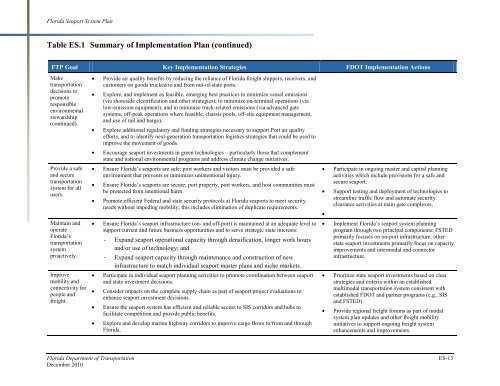Florida Seaport System Plan - SeaCIP
Florida Seaport System Plan - SeaCIP
Florida Seaport System Plan - SeaCIP
Create successful ePaper yourself
Turn your PDF publications into a flip-book with our unique Google optimized e-Paper software.
<strong>Florida</strong> <strong>Seaport</strong> <strong>System</strong> <strong>Plan</strong><br />
Table ES.1 Summary of Implementation <strong>Plan</strong> (continued)<br />
FTP Goal Key Implementation Strategies FDOT Implementation Actions<br />
Make<br />
transportation<br />
decisions to<br />
promote<br />
responsible<br />
environmental<br />
stewardship<br />
(continued).<br />
Provide a safe<br />
and secure<br />
transportation<br />
system for all<br />
users.<br />
Maintain and<br />
operate<br />
<strong>Florida</strong>’s<br />
transportation<br />
system<br />
proactively.<br />
Improve<br />
mobility and<br />
connectivity for<br />
people and<br />
freight.<br />
• Provide air quality benefits by reducing the reliance of <strong>Florida</strong> freight shippers, receivers, and<br />
customers on goods trucked to and from out-of-state ports.<br />
• Explore, and implement as feasible, emerging best practices to minimize vessel emissions<br />
(via shoreside electrification and other strategies), to minimize on-terminal operations (via<br />
low-emission equipment), and to minimize truck-related emissions (via advanced gate<br />
systems, off-peak operations where feasible, chassis pools, off-site equipment management,<br />
and use of rail and barge).<br />
• Explore additional regulatory and funding strategies necessary to support Port air quality<br />
efforts, and to identify next-generation transportation logistics strategies that could be used to<br />
improve the movement of goods.<br />
• Encourage seaport investments in green technologies – particularly those that complement<br />
state and national environmental programs and address climate change initiatives.<br />
• Ensure <strong>Florida</strong>’s seaports are safe; port workers and visitors must be provided a safe<br />
environment that prevents or minimizes unintentional injury.<br />
• Ensure <strong>Florida</strong>’s seaports are secure; port property, port workers, and host communities must<br />
be protected from intentional harm.<br />
• Promote efficient Federal and state security protocols at <strong>Florida</strong> seaports to meet security<br />
needs without impeding mobility; this includes elimination of duplicate requirements.<br />
• Ensure <strong>Florida</strong>’s seaport infrastructure (on- and off-port) is maintained at an adequate level to<br />
support current and future business opportunities and to serve strategic state interests:<br />
- Expand seaport operational capacity through densification, longer work hours<br />
and/or use of technology; and<br />
- Expand seaport capacity through maintenance and construction of new<br />
infrastructure to match individual seaport master plans and niche markets.<br />
• Participate in individual seaport planning activities to promote coordination between seaport<br />
and state investment decisions.<br />
• Consider impacts on the complete supply chain as part of seaport project evaluations to<br />
enhance seaport investment decisions.<br />
• Ensure the seaport system has efficient and reliable access to SIS corridors and hubs to<br />
facilitate competition and provide public benefits.<br />
• Explore and develop marine highway corridors to improve cargo flows to/from and through<br />
<strong>Florida</strong>.<br />
• Participate in ongoing master and capital planning<br />
activities which include provisions for a safe and<br />
secure seaport.<br />
• Support testing and deployment of technologies to<br />
streamline traffic flow and automate security<br />
clearance activities at main gate complexes.<br />
•<br />
• Implement <strong>Florida</strong>’s seaport system planning<br />
program through two principal components; FSTED<br />
primarily focuses on on-port infrastructure; other<br />
state seaport investments primarily focus on capacity<br />
improvements and intermodal and connector<br />
infrastructure.<br />
• Prioritize state seaport investments based on clear<br />
strategies and criteria within an established<br />
multimodal transportation system consistent with<br />
established FDOT and partner programs (e.g., SIS<br />
and FSTED).<br />
• Provide regional freight forums as part of modal<br />
system plan updates and other freight mobility<br />
initiatives to support ongoing freight system<br />
enhancements and improvements.<br />
<strong>Florida</strong> Department of Transportation<br />
December 2010<br />
ES-13
















